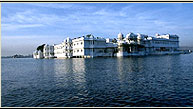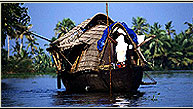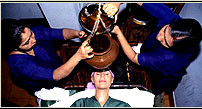-| Indian History | -
 Indus
Valley Civilisation
Indus
Valley Civilisation India's first major civilisation flourished for 1000
years from around 2500 BC along the Indus River Valley in what is now Pakistan.
Its great cities were Mohenjodaro and Harappa, where a civilisation of great
complexity developed. The major cities sites were only discovered during this
century but, other lessr cities have been subsequently unearthed at sites like
Lothal, near Ahmedabad. The origins of Hinduism can be traced all the way back
to this earlycivilisation.
The society was ruled by priests rather than by Kings, and it was they who interceded
with the gods,dictated social modes and determined such issue such as land tnure.
The traditional Hindu fear of pollution and the need for ritual washing is also
reflected in the intricate system of drains found at Harappa. Comparatively
littel is known about the development and eventual demise of this civilisation.
Theer script has still not been deciphered, nor is it known why such an advanced
civilisation co;;apsed so quikly following invasion by the Aryans.
Early Invasions & the Rise of religions
The Aryan invaders swept south from central Asia between 1500 and 200 BC.They
brought their own gods and cattle- raising and meet-eating traditions, But were
absorbed to such a degree that by the 8th century BC the priestly caste had
succeeded in reasserting its supremacy. During the period when the Aryans were
consolidating their hold on northern India, the heartland narrowly missed to
other invasions from the west. The first was by the persian king, Darius (521-486
BC), who annexed the punjab and sind and but went no further.
In 326 BC, alexander the great reached India in his epic march from Greece,
but his troops refused to go further than the Beas River, and he returned back
without extending his power into India. Buddhism arose around 500 BC and presented
Brahamnical Hinuism with its greatest challenge by condemning caste.Buddhism
began to drive a radical swathe through Hinduism in the 3rd century BC when
it was embraced by theMauryan emperor Ashoka, who controlled more of India than
any subsequent ruler prior to the Mughals.
The Mauryas & Ashoka

Chandragupta
Mourya's empire came to power in 321 BC and expanded into the vacuum created
by Alexander's departure. They had a very rigid and well-organised empier. They
also develped an efficient system for collecting taxes and agricultural produce.
There were heavy penaltiesfor those who evaded texes. The empire reached its
peak under emperor Ashoka in 262 BC.
He left pillars which describe the span of his empire. His pillars can be seen
in Gugarat, Orissa, Delhi, Sarnanth in Uttar Pradesh and at Sanchiin Madhya
Pradesh. Under his rule, the mauryan empire cntrolled more of India than probably
any subsequent ruler prior to the Mughals or the British. His empire rapidly
collapsed in 184 BC after his death in 232 BC.
The far south of India had no influence of the rising and falling of kingdoms
in the north. They had long established trading links with the Egyptians,Romans
and South-east Asia. While the Hindu kingdoms ruled in the south and buddhism
was fading in the north, Muslim power was creeping towards India form the Middle
East. The Mughal emperors are the gaints of Indian History. They marched into
the Punjab from Afghanistan, defeated the Sultan of Delhi at panipat in 1525,
and ushered an other golden age of building, arts and literature.
Their rise to power was

rapid, but their decline was equally quick. The Marahta Empire grew during the
17th century, thanks to the larger -than-life exploits of the lower-caste Shivaji,and
gradually took over more of the Mughals domain. The Marathas consolidated control
of central India until they fell to the last great imperial power, the British.
British
power in India was intially exercised by the east India Company, Which established
a trading post at Surat in Gugarat in 1612. The British were not the first or
the only European power with the presence in India in the 17th century: the
portuguese had been in control of Goa since 1510 and the french, Danes and Dutch
as well.
Britian's power grdually spread from the time that Clive retook Calcutta in
1757 until the British victory in the fourth Mysore war in 1799. The long-runing
British struggle with the Marathas was finally concluded in 1803, which left
almost the entire country under the control of the British East India Company.
The British came to India principally to make money, and its culture, belifes
and religions were left strictly alone. The British expanded iron and coal mining,
developed tea, coffee and cotton plantation, and constructed India's vast Rail
network. The indian Mutiny in northern India in 1857, led to the demise of the
East Indian company, and administration of the country was handed over to the
British government. Opposition to British rule began in earnest at the ture
of the 20th century. The 'congress' which had been established to give India
a degree of self-rule now began to push for the real thing.
History in India Reservation
Form




 Indus
Valley Civilisation India's first major civilisation flourished for 1000
years from around 2500 BC along the Indus River Valley in what is now Pakistan.
Its great cities were Mohenjodaro and Harappa, where a civilisation of great
complexity developed. The major cities sites were only discovered during this
century but, other lessr cities have been subsequently unearthed at sites like
Lothal, near Ahmedabad. The origins of Hinduism can be traced all the way back
to this earlycivilisation.
Indus
Valley Civilisation India's first major civilisation flourished for 1000
years from around 2500 BC along the Indus River Valley in what is now Pakistan.
Its great cities were Mohenjodaro and Harappa, where a civilisation of great
complexity developed. The major cities sites were only discovered during this
century but, other lessr cities have been subsequently unearthed at sites like
Lothal, near Ahmedabad. The origins of Hinduism can be traced all the way back
to this earlycivilisation.  Chandragupta
Mourya's empire came to power in 321 BC and expanded into the vacuum created
by Alexander's departure. They had a very rigid and well-organised empier. They
also develped an efficient system for collecting taxes and agricultural produce.
There were heavy penaltiesfor those who evaded texes. The empire reached its
peak under emperor Ashoka in 262 BC.
Chandragupta
Mourya's empire came to power in 321 BC and expanded into the vacuum created
by Alexander's departure. They had a very rigid and well-organised empier. They
also develped an efficient system for collecting taxes and agricultural produce.
There were heavy penaltiesfor those who evaded texes. The empire reached its
peak under emperor Ashoka in 262 BC.  rapid, but their decline was equally quick. The Marahta Empire grew during the
17th century, thanks to the larger -than-life exploits of the lower-caste Shivaji,and
gradually took over more of the Mughals domain. The Marathas consolidated control
of central India until they fell to the last great imperial power, the British.
rapid, but their decline was equally quick. The Marahta Empire grew during the
17th century, thanks to the larger -than-life exploits of the lower-caste Shivaji,and
gradually took over more of the Mughals domain. The Marathas consolidated control
of central India until they fell to the last great imperial power, the British.